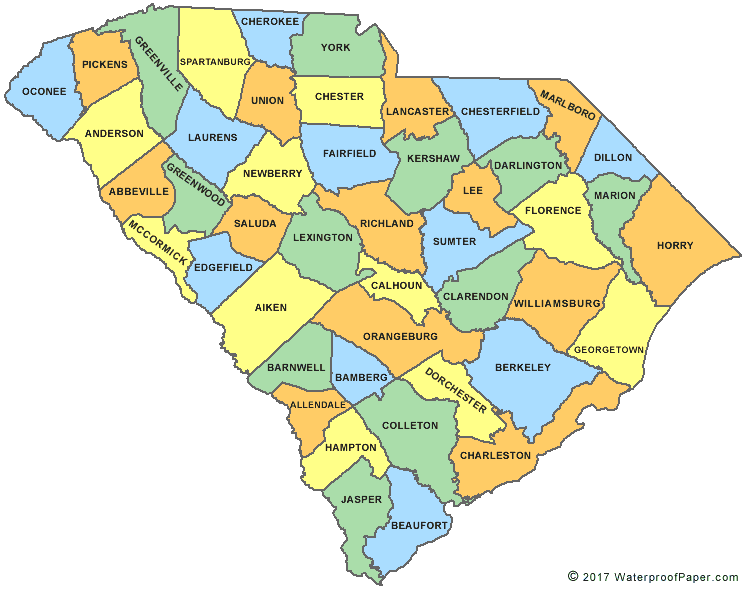South Carolina was one of the original thirteen states of the United States. European exploration of the area began in April 1540, with the Hernando de Soto expedition, who unwittingly introduced new Eurasian diseases that decimated the local Native American population, because they lacked any immunity. In 1663 the English Crown granted land to eight proprietors of what became the colony. The first settlers came to the Province of Carolina at the port of Charleston in 1670; they were mostly wealthy planters and their slaves coming from the English Caribbean colony of Barbados. They started to develop their commodity crops of sugar and cotton. Pushing back the Native Americans in the Yamasee War (1715–17), colonists next overthrew the proprietors' rule, seeing more direct representation. In 1719, the colony was officially made a crown colony; North Carolina was split off and made into a separate colony in 1729.
In the Stamp Act Crisis of 1765, South Carolina banded together with the other colonies to oppose British taxation and played a major role in resisting Britain. It became independent in March 1776 and joined the United States of America. The Revolution was bloody and hard fought in 1780–81, as the British invaded, captured the American army and were finally driven out.
In the early decades, the colony cultivated cotton on plantations of the sea islands and Low Country, along with rice, indigo and some tobacco as commodity crops, all worked by African slaves, most from West Africa. In the 19th century, invention of the cotton gin enabled profitable processing of short-staple cotton, which grew better in the Piedmont than did long-staple cotton. The hilly upland areas, where landowners were generally subsistence farmers with few slaves, were much poorer; a regional conflict between the coastal and inland areas developed in the political system, long dominated by the Low Country planters. With outspoken leaders such as John C. Calhoun, the state vied with Virginia as the dominant political and social force in the South. It fought federal tariffs in the 1830s and demanded that its rights to practice slavery be recognized in newly established territories. With the 1860 election of Republicans under Abraham Lincoln, who vowed to prevent slavery's expansion, the voters demanded secession. In December 1860, the state seceded from the Union; in February 1861, it joined the new Confederate States of America.
In April 1861, the American Civil War began when Confederate forces attacked the American fort at Fort Sumter in Charleston harbor. The Civil War proved devastating to the whites, but freed the blacks from slavery. From 1865 to 1877, South Carolina underwent Reconstruction. Congress shut down the civilian government in 1867, put the Army in charge, gave Freedmen (freed slaves) the vote and prevented ex-Confederates from holding office. A Republican legislature supported by Freedmen, northern Carpetbaggers and white Southern Scalawags created and funded a public school system, and created social welfare institutions. The constitution they passed was kept nearly unaltered for 27 years, and most legislation passed during the Reconstruction years lasted longer than that. By 1877, the white conservatives, called "Redeemers" had regained political power. In the 1880s, Jim Crow laws were passed that were especially severe in the state, to create public segregation and control movement of African American laborers. After 1890, almost all blacks lost their vote, not to regain it until 1965.
The Civil War ruined the economy, and continued dependence on agriculture made South Carolina one of the two or three poorest states for the next century. Educational levels were low as public schools were underfunded, especially for African Americans. Most people lived on small farms and grew cotton. The more affluent landowners subdivided their land into farms operated by tenant farmers or sharecroppers, along with land operated by the owner using hired labor. Gradually more industry moved into the Piedmont area, with textile factories that processed the state's raw cotton into yarn and cloth for sale on the international market.
Wave after wave of revivals made most people quite religious; most people, white and black alike, were Baptists.
Politically the state became part of the Democratic Solid South after whites regained control of the state legislature and governor's office in 1876; they disfranchised African Americans by a new state constitution in 1895, and no black officials were elected between 1900 and 1970. In the first half of the 20th century, many blacks left the state to go to northern cities during the Great Migration. Whites rigidly enforced segregation in the Jim Crow era, limiting African Americans' chances for education, free public movement, and closing them out of the political system. The federal Civil Rights laws of the 1960s ended segregation and protected the voting rights of African Americans. The blacks had been affiliated with the Republican Party, but after 1964 became intensely loyal Democrats, while most white conservatives moved in the opposite direction.
The cotton regime ended by the 1950s. As factories were built across the state, the great majority of farmers left agriculture. Service industries, such as tourism, education and medical care, grew rapidly, as the textile factories faded after 1970 with movement of jobs offshore. By 2000, the white majority of South Carolina voted solidly Republican in presidential elections, but state and local government elections were contested by the two parties. The population continued to grow, reaching 4 million in 2000, as coast areas became prime locations for tourists and retirees. The poverty rate of 13.5% is slightly worse than the national average of 11.7%.


